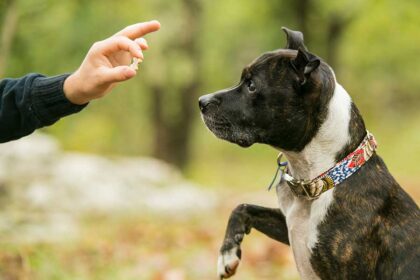Every dog has its own story—some are bold explorers from the moment they open their eyes, while others are shy and cautious, taking time to trust the world around them. No matter their temperament, all dogs share one common need: guidance. Training isn’t just about teaching commands—it’s about building understanding, confidence, and a lasting connection between dog and human.
For many new owners, the idea of training can feel overwhelming at first. It’s easy to assume that only professionals can shape a well-behaved pet, but the truth is, training begins at home. With consistency, patience, and empathy, any owner can help their dog become calmer, more responsive, and happier.
The Power of Positive Reinforcement
Modern dog training emphasizes reward-based methods because they strengthen trust rather than fear. Dogs are eager to please, and they learn best when good behavior is met with something positive—praise, treats, or play. Instead of punishing mistakes, you redirect and reward the behavior you want to see.
This approach not only makes dogs more cooperative but also deepens their emotional connection to you. A dog trained with kindness sees learning as a game rather than a chore. Each session becomes an opportunity for bonding and communication.
Understanding Your Dog’s Emotions
One of the most overlooked aspects of training is emotional awareness. Dogs, like people, have good and bad days. They get tired, distracted, or anxious. Learning to read their cues—like tail movement, ear position, or eye contact—helps you respond appropriately.
For instance, if your dog suddenly resists a command they’ve already learned, it may not be stubbornness but confusion or fatigue. Recognizing this helps you adjust the session gently, keeping progress steady and stress-free.
Patience is your greatest tool. Dogs thrive in calm environments where mistakes are seen as part of the learning process. When you stay relaxed, your dog mirrors that energy and learns more efficiently.
Why Structure Builds Confidence
Structure provides dogs with a sense of security. When routines are predictable—regular walks, feeding times, and training sessions—dogs feel less anxious and more in control of their environment. This structure is especially helpful for reactive or easily distracted pets.
Short, focused sessions work best. Ten minutes of calm, consistent training every day is far more effective than one long, stressful session. Over time, this rhythm builds not just obedience but emotional stability.
Owners who commit to steady practice often notice subtle transformations—less pulling on walks, better recall at the park, and fewer anxious behaviors at home. It’s not about perfection; it’s about progress.
Real-Life Application of Training
The real purpose of training isn’t just about having a dog that sits or stays on command. It’s about developing communication that works in daily life. Whether you’re greeting guests, visiting a vet, or walking through a busy street, training teaches your dog how to behave calmly and confidently.
In growing communities like dog training Garner NC programs, trainers often emphasize real-world exposure—introducing dogs to different environments, people, and sounds. This helps dogs learn to stay composed and focused no matter what’s happening around them. You can apply the same approach at home: practice commands in various locations, gradually adding distractions. The goal is to build reliability through experience.
Socialization: A Key Part of Learning
Dogs are social creatures, and structured interaction plays a big role in their behavior. Early and consistent socialization helps prevent fear-based reactions and aggression later in life.
Expose your dog to other friendly dogs, new people, and everyday sights. Keep the experiences positive and at their comfort level. Socialization isn’t just about play—it’s about learning that the world is safe and interesting.
For puppies, it’s especially important to make these experiences gentle and rewarding. When they associate new things with calm and fun, they grow into confident, well-adjusted adults.
Common Mistakes to Avoid
Even with the best intentions, owners can fall into habits that slow progress. Inconsistency—changing commands, tones, or routines—confuses dogs. Repeating a command without follow-through teaches them to ignore it.
Another common mistake is expecting too much too soon. Training is a gradual process. Dogs don’t automatically understand what we want—they learn through patterns. If a technique isn’t working, reassess rather than repeat it louder. Often, the issue isn’t the dog’s stubbornness but our clarity.
Finally, avoid comparing your dog’s progress to others. Every dog learns differently. Focus on steady improvement rather than perfection.
Training Builds Trust
The beauty of dog training lies in the relationship it creates. When communication flows smoothly, trust blossoms. Your dog learns that you provide direction, safety, and praise—and you learn to listen beyond words.
Over time, this relationship extends far beyond commands. It shows in the way your dog greets you, walks beside you, or looks at you for reassurance. Training strengthens that silent bond more deeply than anything else.
The Reward Beyond Obedience
A trained dog isn’t just obedient—they’re confident, calm, and happier. Training creates a balance where your dog feels secure in knowing what’s expected and free to express their personality within those boundaries.
It’s a process that transforms both owner and pet. You become more patient and understanding, while your dog becomes more trusting and emotionally balanced. The reward isn’t just good behavior—it’s harmony.
Final Thoughts
Dog training is ultimately about connection. It’s about learning to lead with calm authority, communicate with kindness, and celebrate small victories along the way. Whether you’re working through basic commands or more advanced techniques, remember that every session is a step toward mutual respect and understanding.
In time, you’ll find that the lessons learned through training go far beyond obedience—they teach both human and dog the meaning of patience, compassion, and trust.

